What is the MECE principle? A powerful, problem structuring framework
|
|
|
MECE basics | MECE test | MECE example (video)
MECE is a fundamental, problem structuring framework that stands for Mutually Exclusive, Completely Exhaustive. Why is it so popular with management consultants? Well, management consultants essentially spend all day solving problems - it's a huge part of their job. As a result, the better consultants get at quickly decomposing problems and bucketing them into key issues, the better they get at their job!
Who coined the phrase MECE? While it's not exactly clear who coined the phrase MECE, one of the definitive books on logical problem solving and problem structuring is Barbara Minto's The Pyramid Principle. More importantly though, it's used day in and day out by all the leading consulting firms.
Breaking down the MECE principle (Top)
Let's apply the principle of MECE to learning about MECE itself, we'll separate it out into it's own two components and then look at each component in detail. This will give us a thorough understanding of the core principle itself and make it easy for you to apply in any problem structuring situation.
Part 1: Mutually exclusive
Mutually exclusive means that the buckets of a proposed problem solving framework are completely independent of each other. If you think about the individual words themselves, mutually implies that all entities involved share the trait and exclusive means that all entities involved are exclusive (meaning they don't include the others). Thus, mutually exclusive describes a set of entities that definitionally do not include each other. Think of it this way: mutually exclusive is a Venn diagram where the circles do not overlap.
A non mutually exclusive Venn diagram
For a little comic relief, let's consider the entities "Desserts" and "Tacos". Now, ordinarily you might think these are mutually exclusive entities, since anything that's a taco wouldn't be a dessert and vice versa, anything that's a dessert wouldn't be a taco... but, in this case, the innovators at Taco Bell have proved us wrong. Tacos and Desserts aren't mutually exclusive, because Taco Bell invented the Dessert Taco!
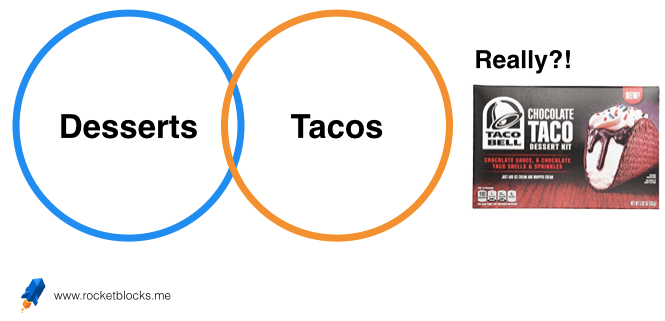
A mutually exclusive Venn diagram
Taking this example a step further, let's consider Milkshakes and Tacos. Barring any crazy Taco Bell innovations, these two entities are 100% mutually exclusive. We can reasonably imagine things like chocolate shakes, vanilla shakes, strawberry shakes which all fit into the milkshakes category and they are completely excluded from the Tacos entity. On the flip side, we can imagine things like chicken tacos, fish tacos, steak tacos and all of those fit squarely in the taco category. In addition, all of those tacos are 100% excluded from the milkshake category.
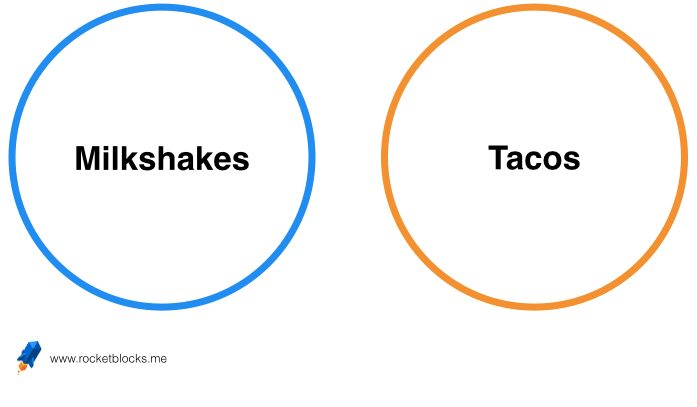
Part 2: Completely exhaustive
What is completely exhaustive? Simply, completely exhaustive means that the entire set of relevant entities is considered. Put another way, a completely exhaustive structure for investigating the problem will have buckets which cover the entire scope of what needs to be looked at. Essentially, you are "exhausting" the set of things to look at.
An incomplete, or unexhausted, set
Let's continue with the example from above and let's do a deep dive on the "Tacos" category. If you wanted to provide an exhaustive look at all types of Tacos, would the following set of entities be exhaustive? The answer is: no. Why? Well, while the example does call out chicken, ground beef and steak tacos, which likely make up most of the Tacos in the world, it doesn't completely exhaust all types. What about shrimp tacos, or fish tacos, or even... dessert tacos?
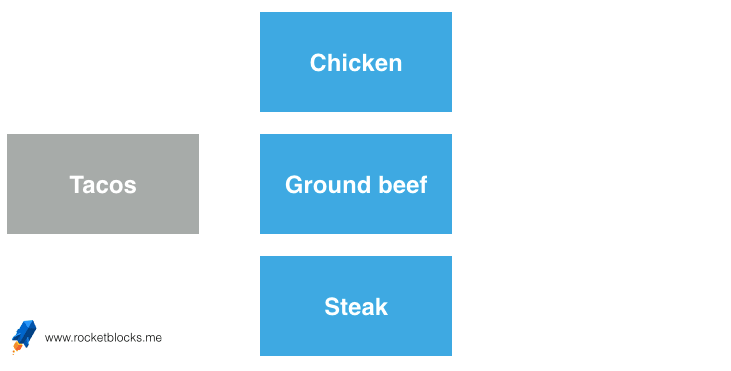
A completely exhaustive set
Now, look at this completely exhaustive set for tacos. It has some similarities to the set above, namely that includes chicken, ground beef and steak, but it has a hierarchy above it which solves some critical problems. Specifically, the exhaustive set starts by setting out meat tacos and non-meat tacos. This is a completely exhaustive set because any taco is either a meat taco or a different type of taco.
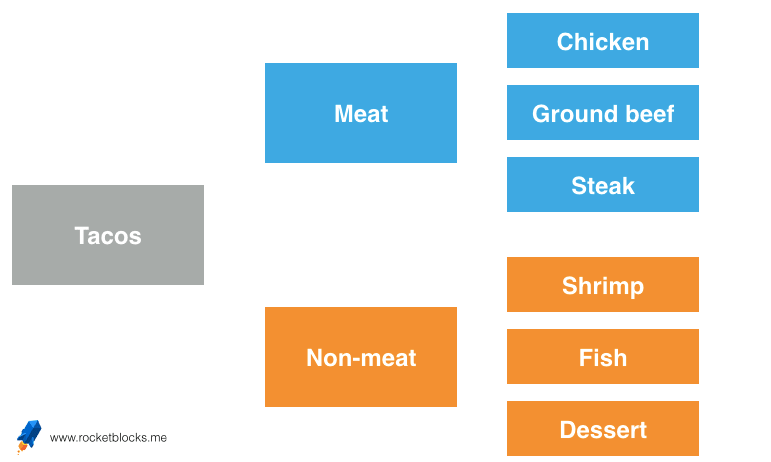
Making it MECE: Putting it all together (Top)
Ok, now that you're clear on what 1) mutually exclusive and 2) completely exhaustive mean, you've got all the building blocks for understanding the MECE principle for problem structuring. So, let's look at our last example and ask ourselves the question: is it a MECE framework? Are the buckets completely mutually exclusive? Is the set of buckets completely exhaustive? One helpful way to test this is pick some real life examples and see if they cleanly fit into the framework. For example, what about tofu tacos? Or duck tacos? Both those would fit into the framework easily, tofu is a non-meat taco and duck fits into meat tacos.
💡 Shameless plug: Build your problem structuring skills with RocketBlocks consulting interview prep
One final test: truly MECE!
Let's consider one last example: a "surf and turf" taco. Does our framework still pass the MECE test? Well, it certainly fails the mutually exclusive component, since it's both a meat and non-meat taco simultaneously. Also, one could argue it's a whole new type of combination tacos so it'd appear our framework isn't completely exhaustive either. Thus, we could MECE proof our structure by adding "Combination tacos" as a new bucket on the same level of meat and non-meat categories.
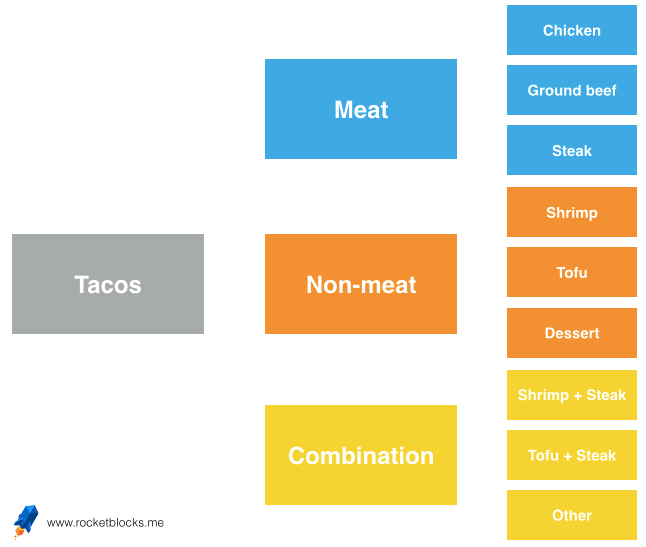
Practical limitations of MECE
Before moving onto a real consulting case example, there is one important thing to call out is: MECE can get complicated quickly! Just think about how much thought went into reaching a MECE framework for laying out all the types of tacos, an example that seems like it should be pretty straight forward! Thus, keep in mind, especially in an interview context, you want to provide a MECE framework but you also want to make sure you're being efficient with your approach. In the above example, it would be reasonable to say something akin to "while I know this framework doesn't account for combination tacos, I believe those are a minor category and thus not material for our analysis." Remember, MECE is a useful tool, but like all useful tools, they do have their practical limits!
A MECE structuring exercise with a real consulting case (Top)
Finally, let's look through a MECE example in the context of a consulting case interview. Here we'll look at two variations of the case prompt "Should our client, who is a large sporting goods manufacturer, acquire a smaller, manufacturer of bicycles based in Minnesota?" To watch the live examples, skip to 4:07 in the embedded video below. If you want a full re-cap of MECE, you can start from the beginning!
Conclusion: Putting the MECE principle to work
MECE is a simple, powerful problem structuring framework. If you follow it, you'll find yourself creating logically organized, independent buckets of analysis that cover the complete set of sub-analyses and considerations. Once you start to get comfortable with the MECE principle, you'll find innumerable use cases for it! Not only will you be able to apply it in your consulting case interviews, but you'll be able to apply it your current job or your studies if you're a student. Furthermore, you can even put this powerful problem structuring to use in your personal life!
If you enjoyed this post, you may also enjoy:
- More mini-lessons from the RocketBlocks YouTube channel
- Deep dive: what do the next five years look like for McKinsey, BCG and Bain
- How much do Partners at McKinsey, BCG and Bain really make?
Read this next:
- Full cases from RocketBlocks
- Be a great mock interview partner
- Mock interview grading templates
- Example case interview prep plans
- Be authentic: advice from a Bain Consultant
- Don't be that candidate
- The Skill Building Loop for case interviews
- Recover from a math error
- Conclude a case interview well
- Acing Accenture's interview process
- How to use RocketBlocks
- Asking great questions in consulting interviews
- How to prep for fall consulting recruiting over the summer
P.S. Are you preparing for consulting interviews?
Real interview drills. Sample answers from ex-McKinsey, BCG and Bain consultants. Plus technique overviews and premium 1-on-1 Expert coaching.



